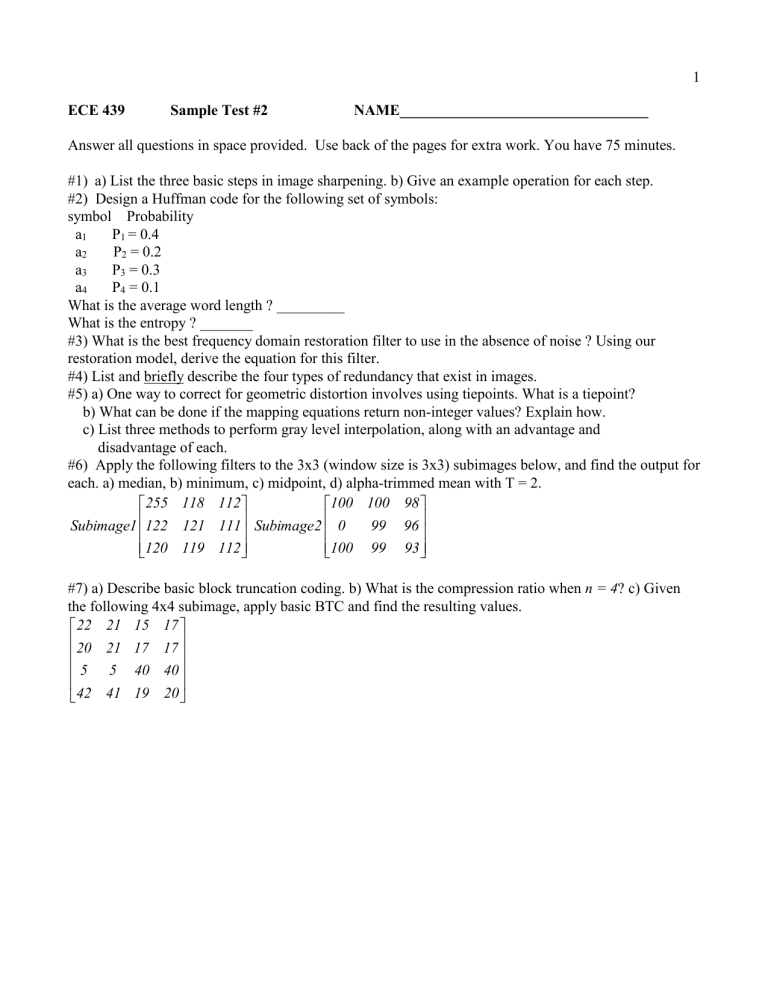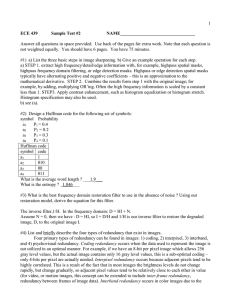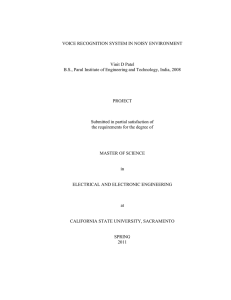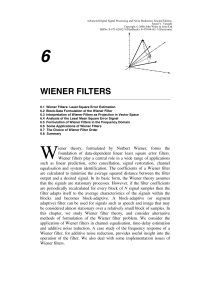439SAMPLEtst2.doc

ECE 439 Sample Test #2 NAME_________________________________
Answer all questions in space provided. Use back of the pages for extra work. You have 75 minutes.
#1) a) List the three basic steps in image sharpening. b) Give an example operation for each step.
#2) Design a Huffman code for the following set of symbols: symbol Probability
a
1
P
1
= 0.4
a
2
P
2
= 0.2
a
3
P
3
= 0.3
a
4
P
4
= 0.1
What is the average word length ? _________
What is the entropy ? _______
#3) What is the best frequency domain restoration filter to use in the absence of noise ? Using our restoration model, derive the equation for this filter.
1
#4) List and briefly describe the four types of redundancy that exist in images.
#5) a) One way to correct for geometric distortion involves using tiepoints. What is a tiepoint?
b) What can be done if the mapping equations return non-integer values? Explain how.
c) List three methods to perform gray level interpolation, along with an advantage and
disadvantage of each.
#6) Apply the following filters to the 3x3 (window size is 3x3) subimages below, and find the output for each. a) median, b) minimum, c) midpoint, d) alpha-trimmed mean with T = 2.
Subimage 1
255
122
120
118
121
119
112
111
112
Subimage 2
100
0
100
100
99
99
98
96
93
#7) a) Describe basic block truncation coding. b) What is the compression ratio when n = 4 ? c) Given the following 4x4 subimage, apply basic BTC and find the resulting values.
22
20
5
42
21
21
5
41
15
17
40
19
17
17
40
20
#8) Mark T for true and F for false.
___ Quantization is a reversible process
___ In the presence of gamma noise, a Wiener filter reduces to an inverse filter.
___ Unsharp masking gives images a “softer” look
___ In image coding, the mapping process is not reversible
___ Order filters are nonlinear filters
___ When measuring image quality with a subjective test, the best type is an impairment test.
___ Image enhancement methods utilize a mathematical model of the image formation process
___ Homomorphic filtering assumes low frequencies are primarily from the lighting
___ PSF stands for “Point Space Feature”
___ A Huffman code is uniform length code
___ With the LBG algorithm, selection of the initial codebook is important
___ In unsharp masking the amount of sharpening is controlled by a histogram shrink
___ Using a gray code in preprocessing can improve RLC results
___ JPEG2000 uses the wavelet transform
___ Objective image quality measures are useful for all applications.
___ Vector quantization encodes subimages, instead of individual pixels.
___ Notch filters are useful for removing periodic noise caused by engine vibration
___ Most real images can be considered to be stationary signals
#9) a) Sketch the histogram of an image with high entropy. b) Sketch the histogram of an image with medium entropy. c) Sketch the histogram of an image with zero entropy
#10) a) Describe the image model used in homomorphic filtering. b) List the assumptions that underlie application of this filter for image improvement. c) Describe an example where the assumptions are not valid.
#11) a) Given the following image, list a sequence of steps that could be used to make the image look better. b) Is the order of operations important? Why or why not?
2
#12) a) What is the power spectrum ratio and how is it related to the signal-to-noise ratio? b) Sketch the filter response of the Wiener and the inverse filter and explain why the Wiener works better in the presence of noise. c) Why use a constant in place of the power spectrum ratio in the Wiener filter?
#13) a) Briefly describe a method for estimating a noise model for an image. b) Briefly describe a method for estimating the degradation function of an image acquisition system.









